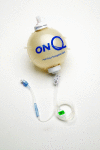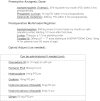The 2012 Chitranjan Ranawat award: intraarticular analgesia after TKA reduces pain: a randomized, double-blinded, placebo-controlled, prospective study
- PMID: 23011843
- PMCID: PMC3528916
- DOI: 10.1007/s11999-012-2596-9
The 2012 Chitranjan Ranawat award: intraarticular analgesia after TKA reduces pain: a randomized, double-blinded, placebo-controlled, prospective study
Abstract
Background: Postoperative pain after total knee arthroplasty remains one of the most important challenges facing patients undergoing this surgery. Providing a balance of adequate analgesia while limiting the functional impact of regional anesthesia and minimizing opioid side effects is critical to minimize adverse events and improve patient satisfaction.
Questions/purposes: We asked whether bupivacaine delivered through an elastomeric device decreases the (1) patients' perception of pain after TKA; (2) narcotic consumption; and (3) narcotic-related side effects as compared with a placebo.
Methods: In this prospective, double-blind, placebo-controlled study, all patients received standardized regional anesthesia, a preemptive and multimodal analgesic protocol, and a continuous intraarticular infusion at 5 mL/hour through an elastomeric infusion pump. The patients were randomized to receive either an infusion pump filled with (1) 300 mL of 0.5% bupivacaine, the experimental group (n = 75); or (2) 300 mL of 0.9% normal saline solution, the control group (n = 75). Data concerning postoperative pain levels through a visual analog scale, postoperative opioid consumption, opioid-related side effects, and complications were collected and analyzed.
Results: Patients in the experimental group receiving the bupivacaine reported a reduction in pain levels in highest, lowest, and current visual analog scale scores compared with the placebo group on the first postoperative day and highest visual analog scale score on postoperative Day 2 along with a 33% reduction in opioid consumption on postoperative Day 2 and a 54% reduction on postoperative Day 3.
Conclusion: In patients undergoing TKA, continuous intraarticular analgesia provided an effective adjunct for pain relief in the immediate postoperative period without the disadvantages encountered with other analgesic methods.
Figures





Comment in
-
Intra-articular infusion with bupivacaine decreased pain and opioid consumption after total knee arthroplasty.J Bone Joint Surg Am. 2013 May 15;95(10):940. doi: 10.2106/JBJS.9510.ebo195. J Bone Joint Surg Am. 2013. PMID: 23677362 No abstract available.
References
-
- Alford JW, Fadale PD. Evaluation of postoperative bupivacaine infusion for pain management after anterior cruciate ligament reconstruction. Arthroscopy. 2003;8:855–861. - PubMed
-
- American Society of Anesthesiologists Task Force on Acute Pain Management Practice guidelines for acute pain management in the perioperative setting: an updated report by the American Society of Anesthesiologists Task Force on Acute Pain Management. Anesthesiology. 2004;6:1573–1581. - PubMed
-
- Brokelman RB, van Loon CJ, Rijnberg WJ. Patient versus surgeon satisfaction after total hip arthroplasty. J Bone Joint Surg Br. 2003;4:495–498. - PubMed
-
- Burroughs TE, Davies AR, Cira JC, Dunagan WC. Understanding patient willingness to recommend and return: a strategy for prioritizing improvement opportunities. Jt Comm J Qual Improv. 1999;6:271–287. - PubMed
Publication types
MeSH terms
Substances
LinkOut - more resources
Full Text Sources
Other Literature Sources
Medical

